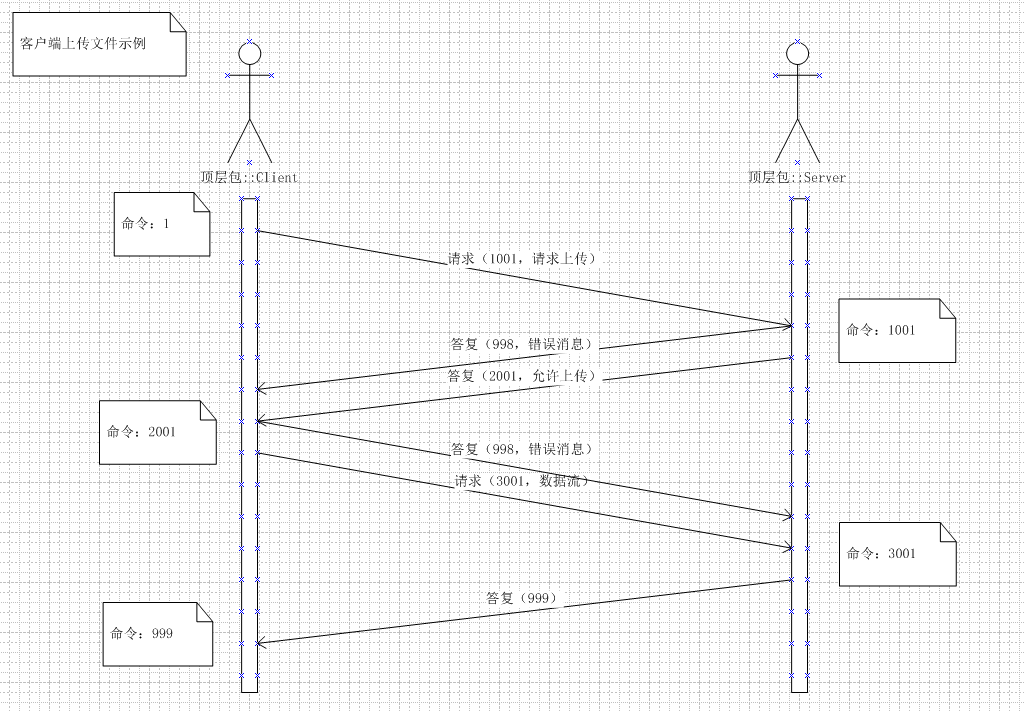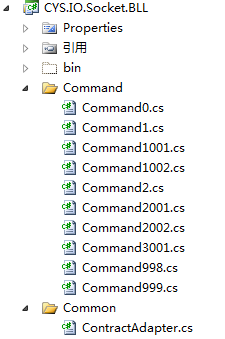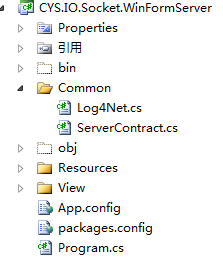项目笔记---C#异步Socket示例
概要
在C#领域或者说.net通信领域中有着众多的解决方案,WCF,HttpRequest,WebAPI,Remoting,socket等技术。这些技术都有着自己擅长的领域,或者被合并或者仍然应用于某些场合。本文主要介绍Socket通讯,因其有着跨平台、跨语言、高性能等优势,适合某些情况的应用以及性能优越的解决方案。
本文是基于一个小项目中的应用,使用了异步方式的Socket通讯,性能上达到多客户端多点通讯,大文件(M-G级别)的文件传输,异步长连接上的性能优势,但此项目也有些不足:未进行大量的外网长时间传输测试,对不稳定的网络状况未做很好的处理,例如加入断点续传功能,对Socket传输错误(其中微软提供了大量的Socket通讯错误代码指示错误类型,请参考http://www.cnblogs.com/Aricc/archive/2010/01/29/1659134.html)未做一个很好的分类处理,只简单的统一为一个类型的错误。所以,此项目介绍只是想抛砖引玉介绍异步Socket通讯,如果有不足或改进之处,还请各位不吝指出。
同步和异步区别
这里的同步和异步指的是服务端Accept接受客户端连接请求的方式。在同步模式下,服务端要开启一个Thread线程循环监听可能来自客户端的服务,如果没有则阻塞,如果有连接则接受连接并存入Connection Pool连接池,这样一个连接(或者说一个连接线程,一般占用系统内存约为2M,具体原因请参考《CLR via C#》中线程章节),这样32位系统下单一应用程序最大内存不超过2G,也就是说,单一连接服务端所能接受客户端最大的请求数为1000(实测下为700+);而异步连接则应用非阻塞式异步连接机制(http://www.cnblogs.com/2018/archive/2011/05/10/2040333.html)BeginAccept异步接受客户端请求并执行相应请求逻辑,在执行完毕后系统能自动优化,并当再次应用时唤醒,从而达到可接受大量的客户端请求,但也限于“同时”执行的客户端数量,对于某些长连接客户端巨大,但并发性小的情景适用。
自定义协议
众所周知,在Socket通讯中传输的普通的字符串或者二进制数据流,不适用于一些复杂的情况,例如约定一个可扩展的协议,可变长协议等,所以本项目采用自定义协议类型来满足可扩展需求:
|
Header |
协议头 |
命令 |
流1长度 |
流2长度 |
|
2字节 |
4字节 |
4字节 |
4字节 |
|
|
Body |
流1 |
流2 |
||
|
N字节 |
N字节 |
|||
说明:
协议头为:FF 7E ,2字节固定值
命令为:命令编号,如1001
流1长度:Int32型指示Body中的流1的长度
流2长度:Int32型指示Body中的流2的长度
流1:字节流
流2:字节流
这样,基于上述协议可自定义流1、流2的长度分别存放不同数据,基于协议还可以对数据协议进行封装,提供公共的解析方式。

1 /// <summary> 2 /// 通讯二进制协议,此协议基于变长的流传输。 3 /// 注:扩展此方法成员时,请重写相关方法。 4 /// </summary> 5 /// <remarks> 6 /// Create By CYS 7 /// </remarks> 8 public class CommunicateProtocol : IDisposable 9 { 10 #region Public Properties 11 /// <summary> 12 /// Byte array length of flag 13 /// </summary> 14 public const int ByteLength_HeaderFlag = 2; 15 /// <summary> 16 /// Byte array length of command 17 /// </summary> 18 public const int ByteLength_HeaderCmd = 4; 19 /// <summary> 20 /// Byte array length of header stream1 21 /// </summary> 22 public const int ByteLength_HeaderStream1Len = 4; 23 /// <summary> 24 /// Byte array length of header stream2 25 /// </summary> 26 public const int ByteLength_HeaderStream2Len = 4; 27 /// <summary> 28 /// 协议头长度 29 /// </summary> 30 public static int FlagLen 31 { 32 get { return ByteLength_HeaderFlag; } 33 } 34 /// <summary> 35 /// 命令(Int32) 36 /// </summary> 37 public int Command 38 { 39 get 40 { 41 return BitConverter.ToInt32(header_Cmd, 0); 42 } 43 set 44 { 45 BitConverter.GetBytes(value).CopyTo(header_Cmd, 0); 46 } 47 } 48 /// <summary> 49 /// 流1长度 50 /// </summary> 51 /// <returns></returns> 52 public int Stream1Len 53 { 54 get 55 { 56 return BitConverter.ToInt32(header_Stream1Len, 0); 57 } 58 set 59 { 60 BitConverter.GetBytes(value).CopyTo(header_Stream1Len, 0); 61 } 62 } 63 /// <summary> 64 /// 流2长度 65 /// </summary> 66 /// <returns></returns> 67 public int Stream2Len 68 { 69 get 70 { 71 return BitConverter.ToInt32(header_Stream2Len, 0); 72 } 73 set 74 { 75 BitConverter.GetBytes(value).CopyTo(header_Stream2Len, 0); 76 } 77 } 78 #endregion Public Properties 79 80 #region Private Properties 81 private static byte[] header_Flag = new byte[ByteLength_HeaderFlag]; 82 private byte[] header_Cmd = new byte[ByteLength_HeaderCmd]; 83 private byte[] header_Stream1Len = new byte[ByteLength_HeaderStream1Len]; 84 private byte[] header_Stream2Len = new byte[ByteLength_HeaderStream1Len]; 85 private byte[] body_Stream1 = new byte[0]; 86 private Stream body_Stream2; 87 #endregion Private Properties 88 89 #region Constructor 90 /// <summary> 91 /// Static constructor 92 /// </summary> 93 static CommunicateProtocol() 94 { 95 header_Flag = new byte[ByteLength_HeaderFlag] { 0xFF, 0x7E }; 96 } 97 98 #endregion Constructor 99 100 #region Public Method 101 /// <summary> 102 /// 判断是否是协议头标志 103 /// </summary> 104 /// <param name="bytes"></param> 105 /// <returns></returns> 106 public static bool CheckFlag(byte[] bytes) 107 { 108 if (bytes.Length != header_Flag.Length) 109 return false; 110 if (bytes.Length != 2) 111 return false; 112 if (!bytes[0].Equals(header_Flag[0]) || !bytes[1].Equals(header_Flag[1])) 113 return false; 114 return true; 115 } 116 /// <summary> 117 /// SetStream1 118 /// </summary> 119 /// <param name="sm"></param> 120 public void SetStream1(byte[] sm) 121 { 122 body_Stream1 = sm; 123 } 124 /// <summary> 125 /// GetStream1 126 /// </summary> 127 /// <returns></returns> 128 public byte[] GetStream1() 129 { 130 return body_Stream1; 131 } 132 /// <summary> 133 /// SetStream2 134 /// </summary> 135 /// <param name="sm"></param> 136 public void SetStream2(Stream sm) 137 { 138 body_Stream2 = sm; 139 } 140 /// <summary> 141 /// body_Stream2 142 /// </summary> 143 /// <returns></returns> 144 public Stream GetStream2() 145 { 146 return body_Stream2; 147 } 148 /// <summary> 149 /// GetHeaderBytes 150 /// </summary> 151 /// <returns></returns> 152 public byte[] GetHeaderBytes() 153 { 154 int offset = 0; 155 byte[] bytes = new byte[ByteLength_HeaderFlag + ByteLength_HeaderCmd + ByteLength_HeaderStream1Len + ByteLength_HeaderStream2Len]; 156 157 Array.Copy(header_Flag, 0, bytes, 0, ByteLength_HeaderFlag); offset += ByteLength_HeaderFlag; 158 Array.Copy(header_Cmd, 0, bytes, offset, ByteLength_HeaderCmd); offset += ByteLength_HeaderCmd; 159 Array.Copy(header_Stream1Len, 0, bytes, offset, ByteLength_HeaderStream1Len); offset += ByteLength_HeaderStream1Len; 160 Array.Copy(header_Stream2Len, 0, bytes, offset, ByteLength_HeaderStream2Len); offset += ByteLength_HeaderStream2Len; 161 162 return bytes; 163 } 164 /// <summary> 165 /// InitProtocolHeader 166 /// </summary> 167 /// <returns></returns> 168 public static CommunicateProtocol InitProtocolHeader(byte[] source) 169 { 170 if (source.Length < ByteLength_HeaderCmd + ByteLength_HeaderStream1Len + ByteLength_HeaderStream2Len) 171 { 172 throw new Exception("byte length is illegal"); 173 } 174 175 byte[] header_cmd = new byte[ByteLength_HeaderCmd]; 176 byte[] header_stream1len = new byte[ByteLength_HeaderStream1Len]; 177 byte[] header_stream2len = new byte[ByteLength_HeaderStream2Len]; 178 Array.Copy(source, 0, header_cmd, 0, ByteLength_HeaderCmd); 179 Array.Copy(source, ByteLength_HeaderCmd, header_stream1len, 0, ByteLength_HeaderStream1Len); 180 Array.Copy(source, ByteLength_HeaderCmd + ByteLength_HeaderStream1Len, header_stream2len, 0, ByteLength_HeaderStream2Len); 181 182 return new CommunicateProtocol 183 { 184 Command = BitConverter.ToInt32(header_cmd, 0), 185 Stream1Len = BitConverter.ToInt32(header_stream1len, 0), 186 Stream2Len = BitConverter.ToInt32(header_stream2len, 0), 187 }; 188 } 189 #endregion Public Method 190 191 #region Private Method 192 193 #endregion Private Method 194 195 #region IDisposable 成员 196 /// <summary> 197 /// Dispose 198 /// </summary> 199 public void Dispose() 200 { 201 header_Cmd = null; 202 header_Stream1Len = null; 203 header_Stream2Len = null; 204 body_Stream1 = null; 205 body_Stream2 = null; 206 } 207 208 #endregion 209 }
通讯机制
传统意义上的上传与下载请求就是,一端发起Request请求,另一端接受并答复请求内容,这样就完成了一次请求应答。然而,如果要实现更多的控制功能,就要在这“一去一回”上增加通信应答次数,类似于TCP的三次握手请求。
其中,当请求被拒绝时,应向请求端发送错误答复998,这样就可以在这个过程中建立一个完善的请求答复机制。


1 public abstract class ContractAdapter 2 { 3 #region Public Method 4 /// <summary> 5 /// 6 /// </summary> 7 /// <param name="p"></param> 8 /// <param name="s"></param> 9 protected void ExecuteProtocolCommand(CommunicateProtocol p, SocketState s) 10 { 11 if (p == null) throw new ArgumentNullException("CommunicateProtocol is null"); 12 switch (p.Command) 13 { 14 case 0: CommandWrapper(((ICommandFunc)new Command0()), p, s); break; 15 case 1: CommandWrapper(((ICommandFunc)new Command1()), p, s); break; 16 case 2: CommandWrapper(((ICommandFunc)new Command2()), p, s); break; 17 case 998: CommandWrapper(((ICommandFunc)new Command998()), p, s); break; 18 case 999: CommandWrapper(((ICommandFunc)new Command999()), p, s); break; 19 // 20 case 1001: CommandWrapper(((ICommandFunc)new Command1001()), p, s); break; 21 case 1002: CommandWrapper(((ICommandFunc)new Command1002()), p, s); break; 22 // 23 case 2001: CommandWrapper(((ICommandFunc)new Command2001()), p, s); break; 24 case 2002: CommandWrapper(((ICommandFunc)new Command2002()), p, s); break; 25 // 26 case 3001: CommandWrapper(((ICommandFunc)new Command3001()), p, s); break; 27 28 default: throw new Exception("Protocol type does not exist."); 29 } 30 } 31 /// <summary> 32 /// 33 /// </summary> 34 /// <param name="func"></param> 35 /// <param name="p"></param> 36 /// <param name="s"></param> 37 protected abstract void CommandWrapper(ICommandFunc func, CommunicateProtocol p, SocketState s); 38 #endregion Public Method 39 }
以及在“命令”中封装,下一个命令。

1 /// <summary> 2 /// 3 /// </summary> 4 public class Command1002 : ICommandFunc 5 { 6 #region ICommandFunc 成员 7 public CommandProfile profile { get; set; } 8 9 /// <summary> 10 /// 11 /// </summary> 12 /// <param name="protocol"></param> 13 /// <param name="state"></param> 14 /// <param name="sobj"></param> 15 /// <returns></returns> 16 public SocketState Execute(CommunicateProtocol protocol, SocketState state, IHSSocket sobj) 17 { 18 state.IsReceiveThreadAlive = false; 19 20 // Check File 21 if (!FileHelper.IsFileExist(profile.UpLoadPath + profile.UpLoadFName)) 22 { 23 var p = ProtocolMgmt.InitProtocolHeader(998, System.Text.Encoding.UTF8.GetBytes("服务端文件不存在"), null); 24 ProtocolMgmt.SendProtocol(state, p, sobj); 25 state.OutPutMsg = string.Format("Command 1002 :服务端文件不存在"); 26 return state; 27 } 28 if (!FileHelper.CanRead(profile.UpLoadPath + profile.UpLoadFName)) 29 { 30 var p = ProtocolMgmt.InitProtocolHeader(998, System.Text.Encoding.UTF8.GetBytes("文件已被打开或占用,请稍后重试"), null); 31 ProtocolMgmt.SendProtocol(state, p, sobj); 32 state.OutPutMsg = string.Format("Command 1002 :文件已被打开或占用"); 33 return state; 34 } 35 36 FileInfo fi = new FileInfo(profile.UpLoadPath + profile.UpLoadFName); 37 using (FileStream fs = new FileStream(profile.UpLoadPath + profile.UpLoadFName, FileMode.Open)) 38 { 39 var p = ProtocolMgmt.InitProtocolHeader(2002, System.Text.Encoding.UTF8.GetBytes(fi.Name), fs); 40 ProtocolMgmt.SendProtocol(state, p, sobj); 41 state.OutPutMsg = string.Format("Command 1002 :发送文件 {0} 成功。", fi.FullName); 42 } 43 44 return state; 45 } 46 47 48 #endregion 49 }
代码结构
项目分为客户端和服务端,其中都依赖于BLL和Core核心类库,Core中封装的是协议头的解析方式、抽象/接口方法、Socket缓冲读取、枚举委托、异步调用基类等,BLL中主要封装的是协议命令,如Command1、Command2001等的具体实现方式。
Core:

BLL:

UI.Client:

UI.Server:

核心思想是将Command的业务需求整合进BLL层次中,而Socket基本的通讯方式等公用功能整合进Core,将UI层释放开,在UI层用Log4net等开源插件进行组合。
总结
基于文字限制,不能讲代码中的每个细节都将到,分析到,还请各位谅解,其中如有不妥之处还请不吝赐教。没有质疑,就没有进步;只有不断的思考才能更好的掌握知识。
最后将程序的源码奉上,希望对您有帮助。
GitHub Project: Here
之前做项目时,项目参考的很多引用没有记住,希望以后有时间补上。
项目中的IP地址,需要根据您的本机IP进行配置,请在WinformServer和WinformClient的Setting文件中更改,同时,还要更改其默认的上传和下载文件,这里没有写成基于OpenFile的方式只是为了演示异步Socket通讯。
引用
Socket通信错误码:http://www.cnblogs.com/Aricc/archive/2010/01/29/1659134.html
异步通讯:http://www.cnblogs.com/2018/archive/2011/05/10/2040333.html
作者:Stephen Cui
出处:http://www.cnblogs.com/cuiyansong
版权声明:文章属于本人及博客园共有,凡是没有标注[转载]的,请在文章末尾加入我的博客地址。
如果您觉得文章写的还不错,请点击“推荐一下”,谢谢。


 浙公网安备 33010602011771号
浙公网安备 33010602011771号